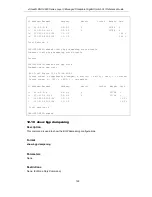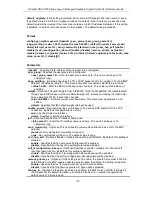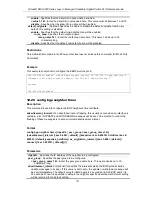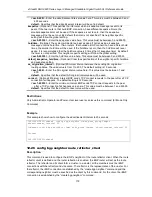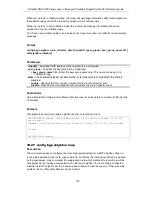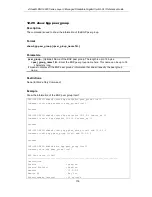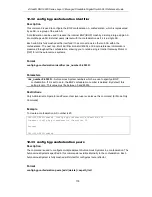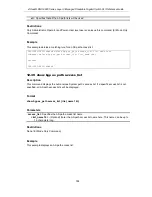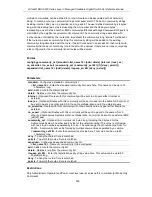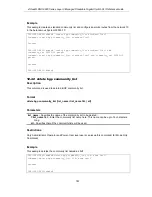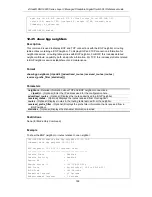
xStack® DGS-3620 Series Layer 3 Managed Stackable Gigabit Switch CLI Reference Guide
177
Keepalive Interval : 60 seconds
Holdtime Interval : 180 seconds
AS Origination Interval : 15 seconds
Connect Retry Interval : 120 seconds
EBGP Multihop : 1
Weight : 0
Next Hop Self : Disabled
Route Reflector Client : Disabled
Send Community : None
Remove Private As : Disabled
AllowAS In : Disabled
Soft Reconfiguration Inbound : Disabled
Default Originate : Disabled
Outbound Route Filter (ORF) type (64) Prefix list:
Send Mode : Disabled
Receive Mode : Disabled
Prefix Max Count : 12000
Prefix Warning Threshold : 75
Prefix Warning Only : Disabled
Total peer_group number : 1
DGS-3620-28SC:admin#
12-30
config bgp route_reflector cluster_id
Description
This command is used to configure the BGP process’s global attribute. The route reflector and its
clients together form a cluster. When a single route reflector is deployed in a cluster, the cluster is
identified by the router ID of the route reflector.
When the cluster ID is 0.0.0.0, the cluster is identified by the router ID. Otherwise, the cluster is
identified by the cluster ID.
The BGP cluster_id command is used to assign a cluster ID to a route reflector when the cluster
has one or more route reflectors. Multiple route reflectors are deployed in a cluster to increase
redundancy and to avoid a single point of failure. When multiple route reflectors are configured in a
cluster, they must be configured with the same cluster ID. This allows all route reflectors in the
cluster to recognize updates from peers in the same cluster and reduces the number of updates
that needs to be stored in BGP routing tables.
This command is only required for the reflector and not the client.
Format
config bgp route_reflector cluster_id <ipaddr>
Parameters
cluster_id
- Specifies the IP address of the cluster ID. Setting the cluster ID to 0.0.0.0 will
remove specifications of the cluster ID. The default value is 0.0.0.0.
<ipaddr>
- Enter the cluster ID's IP address here.

